|
|
||||||
|
Ted Teshima:
|
||||||
|
+ On Tuesday February 28, 2006, Ted's role at Moriyama & Teshima changed to that of a special consultant. I spent a couple of hours with him discussing his past, present and future. We could fill a volume with stories about Ted. Here you will find a few insights.
His families' lives were forever altered when Ted was only three years old. He did not speak about it when I talked to him but it is important for all of us to understand what occurred. Shortly after the Japanese bombed Peal Harbor in December of 1941, the Canadian government ordered all fishing boats operated by Japanese-Canadians be impounded. Sea Island was one of the many fishing communities along the B.C. coast that Japanese-Canadians were now forbidden to live in or visit. His father's fishing boats and their home were confiscated by the government and sold. Japanese-Canadians were either deported back to Japan or moved east within Canada. The Teshima family relocated to the primarily Mormon community of Taber, Alberta. Ted's father managed a farm. The family continued to live in Alberta as Ted progressed through public school until his high school graduation in 1956. Ted excelled in many subjects, particularly mathematics and drawing. It was around grade ten or eleven that Ted was introduced to architecture. The librarian at his high school, noticing Ted's proficiency at drawing, showed him a book containing the work of Frank Lloyd Wright. Two influential and historic designs captured his imagination - the Robie House and Fallingwater. If a person could design something incredible like that, Ted thought, this was for him. Ted applied to the architecture schools at the University of British Columbia, the University of Manitoba and the University of Toronto. The first acceptance to arrive was from the U of T. Of course, a little while later he received acceptance letters from both other schools, but Ted had made his choice and was on his way to Toronto. Upon arrival for the fall 1956 term at the U of T School of Architecture, Ted was one of seventy students in first year. It seemed like he was the only person not from Ontario. Having spent most of his life in a rural community of only 4,000 people, he not as familiar with the urban setting of the downtown campus. Ted's knowledge of large cities, buildings and architecture came from reading books, not first hand experience. Showing how times have changed, there were only five women in first year and one graduated. But like today in the architecture school, it was a group of people with very diverse backgrounds, mainly of European decent.
Upon his graduation from U of T with his degree in architecture in the summer of 1962, Ted went to work for a short time with Page and Steele before coming on board full-time with Raymond Moriyama Architects and Planners. The only other full-time people on staff along with Ray in the 711 Church Street studio were David Vickers and Mrs. Compton who looked after the administrative duties. The conceptual design was being developed for the Japanese Canadian Cultural Centre and it was time to build study models when Ted arrived. Yearning to explore, and after only a brief tenure working with Ray, Ted went to Europe and settled in London, England. After seeing some of their work, Ted visited the offices of Richard Sheppard Robson and Partners to enquire about getting a job there. Not having made the appropriate application in writing, he was about to be turned away when Richard Sheppard spotted Ted in the lobby. After asking him what he was doing there, Richard took Ted into his office for a chat. Apparently young Teshima made an impression. He was hired immediately and worked for RSR for one year. Richard Sheppard Robson was a mid-size firm of about fifty people and Ted has very fond memories of his time there. Most of their projects were educational facilities of all types including residences, churches and administration buildings that were part of the school properties. The firm was working on the master plan and designing buildings for Brunel University, located in West London. Ted worked on the design of the Central Lecture Theatre. To this day it is Brunel's central teaching facility located at the middle of the campus. It was refurbished in 2004. The early 1960's were a vibrant time to be living in London. The Beatles were exploding onto the world scene, followed by the Rolling Stones. Carnaby Street was the hub of the emerging London fashion scene that took the world by storm. It was the flash point of swinging sixties. Ted was there to participate and to witness it all. Wages were low, but the cost of living was reasonable. Not knowing what the market value was for young architect in England at that time, apparently Ted had unknowingly negotiated a better than average salary. Cultural activities were plentiful and Ted took in films, attended the theatre regularly and enjoyed attending lectures at the Royal Institute of British Architects (RIBA). During the weekends he explored the English countryside. Most of the modern architecture being built in London during this era was brutalist with the majority of structures fashioned out of concrete. At Richard Sheppard Robson all the drawings were produced using ink on linen with t-squares. Ted asked them why they worked this way? He suggested that they should use pencil on tracing paper as they do in Canada. If you make a mistake, you just erase it and draw again. Ted and his colleague Tony Parsons got the go-ahead to draw up their project using this method with the goal of producing the set more efficiently. They succeeded in their task. RSR were now the only firm in England using this drawing method. The office was in a five-storey building. Richard Sheppard was a paraplegic so it was very difficult for him to get to the upper levels. Ted and Tony were stationed on the top floor. Despite his disability, Richard would periodically make his way up to the fifth floor using the stairs, the only way up. Ted said they could always hear him coming. Once he arrived Ted recalls having wonderful discussions about architecture with the bearded rough spoken Sheppard and colleague Tony Parsons. Unlike Canada where on your last day in the office people take you out, in England you take the office to the pub and pay the bill! Richard Sheppard told Ted that they were so pleased with his work that he should send over some more colonials. And Ted actually did! Blandford Gates went to work in the RSR office after spending some time in Finland. Ted and his wife Ikuko bought an old second hand VW, a tent and some camping gear. They spent the next seven or eight months traveling through Europe. Ted had carefully mapped out the route based on significant architectural projects he wanted to visit. For three weeks while in northern Italy they were joined by George Baird, the current Dean of the Faculty of Architecture, Landscape, and Design at the University of Toronto, and his wife Elizabeth, the now well known Canadian Living food editor.
Further adventures followed taking Ted and Ikuko through Scandinavia including Finland. Eventually they ran out of money and a loan was required to get enough funds to return to Canada. It was now early in 1966. Ted got a job at Klein and Sears and stayed there about six months. David Vickers got in touch with Ted and encouraged him to return to work at Raymond Moriyama Architects and Planners. When Ted arrived the office had just moved to 32 Davenport Road from 711 Church Street. In fact the construction, under the supervision of Anson Finlay, was not yet complete. It was quite a different office from the one Ted left a few years earlier. Instead of three or four people, there were now fifteen or twenty. Recent additions included Bon Mueller and Don Cooper. There were a number of people who also joined in 1966 - Anson Finlay, John Snell, Aubrey McIntosh, Joni Inouye and Mary Sabat. Tom Motomochi was also making his first appearances. July 25, 2006 marks 40 years for the office at 32 Davenport and the year 2006 is Ted's 40th year since his full-time return to the firm. The big project on the go was the Centennial Centre for Science and Technology we now know as the Ontario Science Centre. The pre-cast shop drawings were coming in for all the curved pieces that made up the Great Hall so one of Ted's early tasks was to check them.
Many of the firms key projects from the late 1960's on had the team of Ray as the designer and Ted as the Project Manager/Architect. One example was the Scarborough Civic Centre. The innovative open atrium design was not permitted under the building code at that time. Ted and the team working with a code consultant from Chicago, demonstrated equivalence to the existing fire codes and got approval to build the desired design. The office developed a close relationship with the administrative staff in Scarborough. It was also the late 1960's when the office first started to design projects for universities. The Minota Hagey Residence and the Health Sciences Building both at Waterloo were two of the first ones. In 1970, Ted became a partner in Moriyama and Teshima Architects and Planners. Thus began a thirty-six year relationship as Ray's partner. This was also the era that saw long time staff members George Stockton, John Blakey and Roy Gill join the office. Under the new partnership in the 1970's and into the 1980's the variety of work the firm undertook kept expanding. Many more university clients were added including Brock, Guelph and York where the Phase 1 Arts Building was completed. It was during this time that two legacy projects of Moriyama & Teshima were completed - The Metro Toronto Reference Library on Yonge Street (now renamed the Toronto Reference Library) and Science North in Sudbury. Ted faced a new unexpected challenge in the mid-1970's. Ray took a one-year sabbatical from the office. Every once in a while Ray would check in, from places like India, but all of a sudden Ted had much more responsibility as the lone partner in the office. As Ted explained, two things happened immediately. First he had to meet with the Chairman of the Board of the Metro Library to explain how the project would proceed in Ray's absence. The second was a presentation of the Malton Community Centre project to the local politicians and staff that had to be made. Ray had been working with them on the project and before Ted could make his well prepared presentation Hazel McCallion got up and questioned Ted. She wanted to know if it was true that Ray was leaving the practice! Ted explained that it was only a sabbatical and that Ray would return in about a year, just like professors do at universities. He assured her that Ray had been involved in the design. Hazel then stated that this was good enough for her and that the project should be approved. Ted must have been as convincing in his explanations then as he is now. The project was approved, and he did not have to make the presentation after all!
Some projects Ted found especially rewarding. One was the River Run Centre where he collaborated with Daniel Teramura. Ted guided the project team through a very complex process. There were challenges with the site and program issues with the community. The budget was very limited. At first they hoped to have a stone clad building, but didn't have the funds to achieve this. And as happened during the Scarborough Civic Centre projects, under Ted's leadership ties were forged with the people in Guelph involved in the project. Many of the same issues have arisen during the current Guelph Civic Administration Centre Complex project where the team again has benefited from Ted's reasoned approach. Anyone who has seen Ted going over design concerns, budget or program issues with clients has experienced his magic touch. He has a way of explaining situations so logically and clearly that even potential doubters or rivals inevitably come on side. Ted designed the Seicho No Ie Church in Toronto, and with the assistance of Roy Gill, created a finely detailed gem. As Moriyama & Teshima moved into the 1990's a shift was occurring and Ted saw the importance of starting to plan for transition within the firm. The initial plan had Raymond retiring by the year 2000 and Ted doing the same shortly afterwards. By late in the decade the transition plan was being finalized and in 1998 the four current partners were announced. By now Ted was spending at least one third of his time on public relations and the preparation of proposals to try and get projects. How commissions were obtained had completely changed. Ted recalls four months spent on the Kuwait University proposal alone. In the 1960's firms never had to do proposals. Clients would come and meet with you before selecting an architect, there were occasional design competitions and sometimes you were just awarded a project. Ted also spoke of how the process of executing a project today is much more rigorous. We have to deal with value engineering and there is a greater need to rationalize every decision you make. This takes much more of our time. In the past more was left in the hands of the architects. Clients can't just award you a project now, but there is more fairness as getting commissions is based less on connections and who you know than it was in the past. Ted has many honours and accomplishments. He is a Fellow of the Royal Architectural Institute of Canada and Royal Society of Arts (England) and a member of the Ontario Association of Architects and Architectural Institute of British Columbia. He was Director of the Board of the Ontario Heritage Foundation from 1983 to 1990. Ted has been a member of Advisory Board, School of Architecture and Landscape Architecture, University of Toronto, since 1987. In 2002 Ted received a very special award from the OAA (Ontario Association of Architects) at the Celebration of Excellence Reception in Niagara Falls, Ontario. A Powerpoint presentation with images of Ted and his work was shown to all those in attendance. The following quote explains its significance: "The Order of da Vinci is an honour that is awarded to architects who have demonstrated exceptional leadership in the profession, in education, and/or in service to architecture and the community." This describes Ted to a T. A couple of years ago Ted thought he could reduce his time in the office as part of the firm's transition but he seemed to be working at least as many hours as before, and perhaps more! When Raymond became a consultant to the firm in 2004 Ted knew he would be doing the same quite soon. Recent projects where Ted has been a key player are the Kuwait University Master Plan and all the projects for Imara and the Aga Khan. More than once Ted has made critical presentations to His Highness, The Aga Khan for the Wynford Drive and The Delegation of The Ismaili Imamat projects. Despite how many times Ted has told the clients he is reducing his involvement in the office, they do not seem to believe him and are having a hard time accepting it. Like everyone he has encountered I'm sure, they like Ted and they will miss his contributions and leadership. Ted's new role, similar to Raymond, is as a consultant to Moriyama & Teshima. He cleaned out his office in the loft and is available to us for selected projects.
Future plans, apart from skiing and golf, include excursions to China and Botswana in Africa. Ted likes to cook but he says he follows the recipes like it was a specification carefully measuring the ingredients. The better part of a day can be spent preparing a special meal. As Ted joked, maybe he just needs a good sous-chef! He used to be a member of a gourmet club where the host prepares the main dish and the guests supply the other courses. This article can only attempt to give a sense of Ted's history and contribution to our office over the years. Ted has always been a solid leader and we have all learned so much from working with him. Read some of the exceptional words I have gathered from people that follow in tribute to Ted. They tell it all! |
||||||
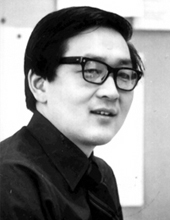 Theodore Fujio Teshima, or Ted as we all know him, was born in Sea Island B.C. in the year 1938. Sea Island was a small village on the flatlands at what is modern day Richmond, B.C., on land that is now part of Vancouver International Airport. The family, which included a sister and a brother, lived in a house near the ocean since Ted's father was a successful fisherman who owned two fishing vessels. Even though he was only age two or three Ted remembers swimming in the ocean and the strawberries that grew in their garden.
Theodore Fujio Teshima, or Ted as we all know him, was born in Sea Island B.C. in the year 1938. Sea Island was a small village on the flatlands at what is modern day Richmond, B.C., on land that is now part of Vancouver International Airport. The family, which included a sister and a brother, lived in a house near the ocean since Ted's father was a successful fisherman who owned two fishing vessels. Even though he was only age two or three Ted remembers swimming in the ocean and the strawberries that grew in their garden.
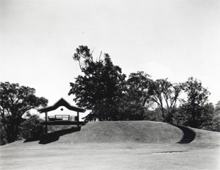 The paths of Raymond Moriyama and Ted Teshima first crossed in the early 1960's. Raymond, after graduating from the architecture program at the U of T in 1954 and then obtaining a Masters of Architecture from McGill University in Montreal in 1957, set up his practice in Toronto as a sole practitioner in 1958. Two of the Ray's early projects were published and they caught Ted's attention - the Gatehouse for Crothers Used Equipment facility built of scrap iron and the Halfway House, also designed for the Crother's family. But it was a small house Ray designed for Bill Brady in 1960 that was built near the Scarborough Bluffs that Ted said really brought him in. Ted first worked for Ray as a summer student after his fourth year of studies. When Ted was in his graduation year of 1961/62, Raymond taught one of the studio classes.
The paths of Raymond Moriyama and Ted Teshima first crossed in the early 1960's. Raymond, after graduating from the architecture program at the U of T in 1954 and then obtaining a Masters of Architecture from McGill University in Montreal in 1957, set up his practice in Toronto as a sole practitioner in 1958. Two of the Ray's early projects were published and they caught Ted's attention - the Gatehouse for Crothers Used Equipment facility built of scrap iron and the Halfway House, also designed for the Crother's family. But it was a small house Ray designed for Bill Brady in 1960 that was built near the Scarborough Bluffs that Ted said really brought him in. Ted first worked for Ray as a summer student after his fourth year of studies. When Ted was in his graduation year of 1961/62, Raymond taught one of the studio classes.
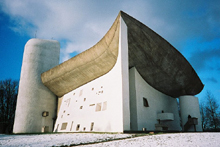 Although you could get a sense of architectural designs from pictures and books, Ted found experiencing them live separates the good from the great. Two projects by Le Corbusier made this very apparent - The Monastery of Sainte-Marie de La Tourette and the Chapel of Notre Dame du Haut more commonly known as Ronchamps, both in France.
Although you could get a sense of architectural designs from pictures and books, Ted found experiencing them live separates the good from the great. Two projects by Le Corbusier made this very apparent - The Monastery of Sainte-Marie de La Tourette and the Chapel of Notre Dame du Haut more commonly known as Ronchamps, both in France.
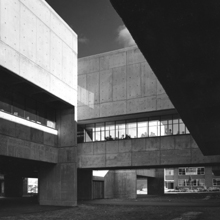 The first project that Ted was assigned the duties of Project Architect was the new Parkland Senior School. It turned out that the site used to be a garbage dump. With conventional design and construction methods there were concerns about methane gas entering the building that could potentially lead to explosions. Working with the structural engineers, Ted helped the team develop a design that placed the building on concrete stilts so that it hovered above the ground.
The first project that Ted was assigned the duties of Project Architect was the new Parkland Senior School. It turned out that the site used to be a garbage dump. With conventional design and construction methods there were concerns about methane gas entering the building that could potentially lead to explosions. Working with the structural engineers, Ted helped the team develop a design that placed the building on concrete stilts so that it hovered above the ground.
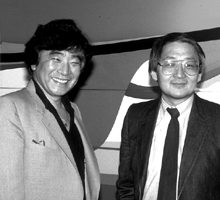 Through the 1980's the firm prospered and grew. By the late 80's there were over forty-five people at M&T as the number of people on staff doubled through the decade. Included in those who joined the firm during this time were the four future partners Ajon Moriyama, Jason Moriyama, Diarmuid Nash and Daniel Teramura. Projects that Ted was involved in included The Government of Canada Building in Scarborough,
Through the 1980's the firm prospered and grew. By the late 80's there were over forty-five people at M&T as the number of people on staff doubled through the decade. Included in those who joined the firm during this time were the four future partners Ajon Moriyama, Jason Moriyama, Diarmuid Nash and Daniel Teramura. Projects that Ted was involved in included The Government of Canada Building in Scarborough, 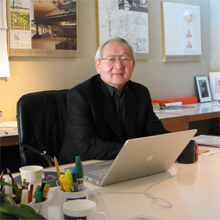 His first order of non-business was a week spent skiing at Lake Louise. Later this summer Ted and Ikuko will be taking a slow journey along the west coast of Canada towards Tofino on Vancouver Island. A voyage not unlike their camping trip through Europe in the early 1960's. Their three sons - John, a doctor, Paul who is a VP in an IT firm and Nicolai, who works for IBM in Vancouver, will bring themselves and their families to Vancouver Island for a much anticipated gathering of the Teshima clan.
His first order of non-business was a week spent skiing at Lake Louise. Later this summer Ted and Ikuko will be taking a slow journey along the west coast of Canada towards Tofino on Vancouver Island. A voyage not unlike their camping trip through Europe in the early 1960's. Their three sons - John, a doctor, Paul who is a VP in an IT firm and Nicolai, who works for IBM in Vancouver, will bring themselves and their families to Vancouver Island for a much anticipated gathering of the Teshima clan.